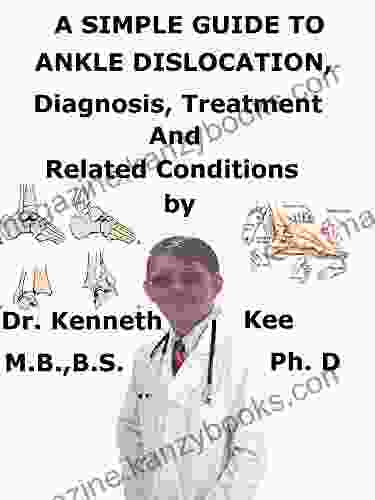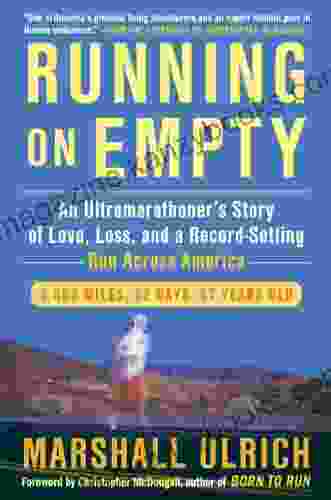A Simple Guide to Ankle Dislocation: Diagnosis, Treatment, and Related Conditions

4 out of 5
| Language | : | English |
| File size | : | 629 KB |
| Text-to-Speech | : | Enabled |
| Screen Reader | : | Supported |
| Enhanced typesetting | : | Enabled |
| Word Wise | : | Enabled |
| Print length | : | 110 pages |
| Lending | : | Enabled |
Ankle dislocation is a serious injury that can occur when the bones of the ankle are forced out of their normal alignment. This can be a very painful and debilitating injury, and it can take several weeks or even months to fully recover.
In this guide, we will discuss the different types of ankle dislocations, their causes, and the best ways to treat them. We will also provide information on how to prevent ankle dislocations and how to manage the pain and swelling associated with this injury.
Types of Ankle Dislocations
There are three main types of ankle dislocations:
- Anterior dislocation: This is the most common type of ankle dislocation, and it occurs when the foot is forced forward and out of the ankle joint. This can happen during a fall, a sports injury, or a car accident.
- Posterior dislocation: This type of dislocation occurs when the foot is forced backward and out of the ankle joint. This can happen during a fall or a sports injury.
- Lateral dislocation: This type of dislocation occurs when the foot is forced to the side and out of the ankle joint. This can happen during a fall or a sports injury.
Causes of Ankle Dislocation
Ankle dislocations can be caused by a variety of factors, including:
- Trauma: This is the most common cause of ankle dislocations, and it can occur during a fall, a sports injury, or a car accident.
- Ligament laxity: This is a condition in which the ligaments that support the ankle are loose, which can make the ankle more vulnerable to dislocation.
- Ankle instability: This is a condition in which the ankle is not stable, which can make it more likely to dislocate.
Symptoms of Ankle Dislocation
The symptoms of ankle dislocation can vary depending on the severity of the injury. Some of the most common symptoms include:
- Pain: This is the most common symptom of ankle dislocation, and it can be severe.
- Swelling: This is another common symptom of ankle dislocation, and it can make it difficult to walk.
- Bruising: This is a common symptom of ankle dislocation, and it can appear anywhere on the ankle or foot.
- Numbness or tingling: This is a symptom of ankle dislocation that can occur if the nerves in the ankle are damaged.
- Deformity: This is a symptom of ankle dislocation that can occur if the bones of the ankle are severely displaced.
Diagnosis of Ankle Dislocation
Ankle dislocation is diagnosed based on a physical examination and an X-ray. The physical examination will reveal the symptoms of ankle dislocation, and the X-ray will confirm the diagnosis.
Treatment of Ankle Dislocation
The treatment of ankle dislocation depends on the severity of the injury. Some of the most common treatments include:
- Closed reduction: This is a non-surgical procedure in which the doctor manipulates the bones of the ankle back into their normal alignment. This procedure is usually done under sedation.
- Open reduction: This is a surgical procedure in which the doctor makes an incision in the ankle and manipulates the bones of the ankle back into their normal alignment. This procedure is usually done if the closed reduction is unsuccessful.
- Immobilization: This is a treatment in which the ankle is immobilized in a cast or brace. This helps to keep the bones of the ankle in place and to prevent further injury.
- Physical therapy: This is a treatment in which the patient works with a physical therapist to improve the range of motion and strength in the ankle.
Prevention of Ankle Dislocation
There are a number of things that you can do to prevent ankle dislocation, including:
- Wear proper footwear: This means wearing shoes that fit well and provide good support for the ankle.
- Warm up before exercising: This helps to prepare the muscles and ligaments in the ankle for activity.
- Stretch the muscles and ligaments in the ankle: This helps to keep them flexible and less likely to be injured.
- Avoid activities that put stress on the ankle: This includes activities such as running, jumping, and playing sports.
Management of Pain and Swelling
There are a number of things that you can do to manage the pain and swelling associated with ankle dislocation, including:
- Ice: This helps to reduce pain and swelling.
- Elevation: This helps to reduce swelling.
- Compression: This helps to reduce swelling.
- Medication: This can help to relieve pain and inflammation.
Related Conditions
There are a number of conditions that can be related to ankle dislocation, including:
- Ankle sprain: This is a common injury that occurs when the ligaments in the ankle are stretched or torn.
- Ankle fracture: This is a common injury that occurs when the bones of the ankle are broken.
- Achilles tendon rupture: This is a serious injury that occurs when the Achilles tendon is torn.
- Tarsal tunnel syndrome: This is a condition that occurs when the nerve that runs through the tarsal tunnel is compressed.
Ankle dislocation is a serious injury that can have a significant impact on your life. However, with proper treatment and care, most people can fully recover from this injury. If you have dislocated your ankle, it is important to see a doctor right away to get the proper treatment.
4 out of 5
| Language | : | English |
| File size | : | 629 KB |
| Text-to-Speech | : | Enabled |
| Screen Reader | : | Supported |
| Enhanced typesetting | : | Enabled |
| Word Wise | : | Enabled |
| Print length | : | 110 pages |
| Lending | : | Enabled |
Do you want to contribute by writing guest posts on this blog?
Please contact us and send us a resume of previous articles that you have written.
 Book
Book Novel
Novel Page
Page Chapter
Chapter Text
Text Story
Story Genre
Genre Reader
Reader Library
Library Paperback
Paperback E-book
E-book Magazine
Magazine Newspaper
Newspaper Paragraph
Paragraph Sentence
Sentence Bookmark
Bookmark Shelf
Shelf Glossary
Glossary Bibliography
Bibliography Foreword
Foreword Preface
Preface Synopsis
Synopsis Annotation
Annotation Footnote
Footnote Manuscript
Manuscript Scroll
Scroll Codex
Codex Tome
Tome Bestseller
Bestseller Classics
Classics Library card
Library card Narrative
Narrative Biography
Biography Autobiography
Autobiography Memoir
Memoir Reference
Reference Encyclopedia
Encyclopedia Tasche Laine
Tasche Laine Miss Marti Pants
Miss Marti Pants Keith Erlandson
Keith Erlandson Wang Yun
Wang Yun Miodrag Ilic
Miodrag Ilic Kerri Simpson
Kerri Simpson Yong Chen
Yong Chen Kevin P Winn
Kevin P Winn Ken Wilson
Ken Wilson Shawn Mcclendon
Shawn Mcclendon Kelly J Caselman
Kelly J Caselman Kelly Terwilliger
Kelly Terwilliger Nicole Centeno
Nicole Centeno Steve Bruno
Steve Bruno Ken Keffer
Ken Keffer Kim Ann
Kim Ann Michael Ezeanaka
Michael Ezeanaka Jason Gruhl
Jason Gruhl Milo Miloradovich
Milo Miloradovich Nick Bostrom
Nick Bostrom
Light bulbAdvertise smarter! Our strategic ad space ensures maximum exposure. Reserve your spot today!

 Jarrett BlairHealthy Scratch-Made Freezer Meals for Busy Nurses and Students: Nourishment...
Jarrett BlairHealthy Scratch-Made Freezer Meals for Busy Nurses and Students: Nourishment...
 J.R.R. TolkienThe One-of-a-Kind Cheese Cookbook: A Culinary Odyssey for Cheese Aficionados
J.R.R. TolkienThe One-of-a-Kind Cheese Cookbook: A Culinary Odyssey for Cheese Aficionados
 Patrick RothfussEmbark on a Gluten-Free Journey with The Easy Start Guide to Gluten Freedom
Patrick RothfussEmbark on a Gluten-Free Journey with The Easy Start Guide to Gluten Freedom
 Julian PowellUnleash the Adventure with "The Bears' Picnic": A Magical Journey for Young...
Julian PowellUnleash the Adventure with "The Bears' Picnic": A Magical Journey for Young... Foster HayesFollow ·12.2k
Foster HayesFollow ·12.2k Gene PowellFollow ·13.6k
Gene PowellFollow ·13.6k Bo CoxFollow ·10.5k
Bo CoxFollow ·10.5k Pete BlairFollow ·2.8k
Pete BlairFollow ·2.8k Fernando PessoaFollow ·6.7k
Fernando PessoaFollow ·6.7k Dan HendersonFollow ·2.3k
Dan HendersonFollow ·2.3k William GoldingFollow ·13.3k
William GoldingFollow ·13.3k Aron CoxFollow ·11.5k
Aron CoxFollow ·11.5k

 Ernesto Sabato
Ernesto SabatoLoving Table: Creating Memorable Gatherings
Gatherings...

 Mark Twain
Mark TwainLifestyle After Cancer: The Facts
Cancer is a life-changing...

 Keith Cox
Keith CoxUnlocking the Nutritional Needs of Individuals with...
Individuals with physical disabilities...

 Rubén Darío
Rubén DaríoHandbook And Guide To Evaluation And Treatment
Empowering Healthcare...

 Andy Hayes
Andy HayesUnveiling the Truth: "Garden Myths" by Robert Pavlis...
The world of gardening is often filled with a...
4 out of 5
| Language | : | English |
| File size | : | 629 KB |
| Text-to-Speech | : | Enabled |
| Screen Reader | : | Supported |
| Enhanced typesetting | : | Enabled |
| Word Wise | : | Enabled |
| Print length | : | 110 pages |
| Lending | : | Enabled |






